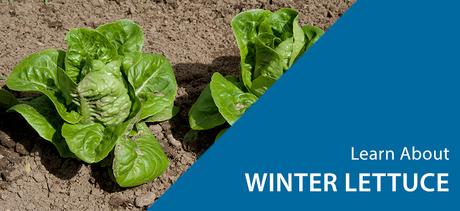
Lettuce is one of the most common sights on any garden plot, and for good reason.
They're easy to grow, and provide big, leafy satisfaction when harvested. What you may not know, is that some varieties can yield harvests much later in the autumn, and even in the winter - with a little extra care and attention. The yield may be a bit smaller, but all the more satisfying for the time of year.
The winter lettuces should be sown from mid-August through September and October, a bit at a time to create an ongoing supply of harvest-ready leaves. You should have crops reaching maturity throughout the winter months - even if you don't have a greenhouse.
Because lettuces are prone do damage in heat and drought conditions, winter lettuces are in many ways better off. A sunny spot, sheltered from strong winds is best. They may stop growing during very cold or frosty weather, but they will resume when the sun burns away the frost, making all the progress they need to survive and thrive. As with all new crops, you'll want to dig in some organic materials before sowing, to ensure the soil has enough nutrients to support steady growth.
You can grow lettuce outdoors all year long in warmer parts of the UK, but in any part of the country they will flourish in pots on a window sill, or in a greenhouse (with minimal heat in colder areas).
If growing them outdoors, sow them in rows with about 10-15cm between them. If a rod-straight row makes your chest swell with pride and satisfaction, use a couple of pegs and a string to ensure the look you want. Make 1cm deep drills about 30cm apart, putting a few seeds into the bottom of each before pinching closed and gently tamping down the row. Give a gentle but ample initial watering, and then keep it from drying out throughout the growing season. Plant from mid-August through to the end of October, created stages of growth to stagger your harvests.
One thing to watch for when planting lettuce, is the pre-germination temperature. Lettuce seeds will only germinate if sown in temperatures below 25°C. Once in and established, they are a bit hardier, but during this susceptible time, care should be taken; plant on a cooler day, with a few more cool days in the forecast. Thin out the seedlings to allow ample growing space. Some varieties need only 15cm, others need up to 30cm. Keep the healthiest specimens wherever possible, but if spacing well means pulling out a good grower, don't despair too much - you can eat all of these just as you would the mature leaves. It will give you a sweet, crunchy little salad.

When the year wanes and frost becomes a possibility, you may want to protect your plants with cloches or agricultural fleece. Just place the covering over the plants prior to the expected cold period, and remove it afterward. If you have the time, you may want to put them on each night and remove them as soon as the sun burns away the frost each day.
If the year is an especially wet one, a solid cloche will have the added bonus of preventing the soil from waterlogging.
It is important to give winter crops every advantage, so keep out the weeds and water regularly - but gently - as needed.
The crops you planted in August should be ready for initial harvest by October, and depending on how much you planted, and how many stages you planned, you should be well supplied throughout the winter months and even into the spring.
Many people pick the individual leaves as soon as they are 5-7cm tall, while others wait a bit longer and take the lettuce plant all at once. The benefit of taking a few leaves at a time is that they will often regrew, providing a second or third yield from the same plants sometimes right into April before they go to seed.
References: https://en.wikipedia.org/wiki/Lettuce http://www.foodreference.com/html/artromainecoslettuce.html http://agriculture.vic.gov.au/agriculture/horticulture/vegetables/vegetables-a-z/lettuce